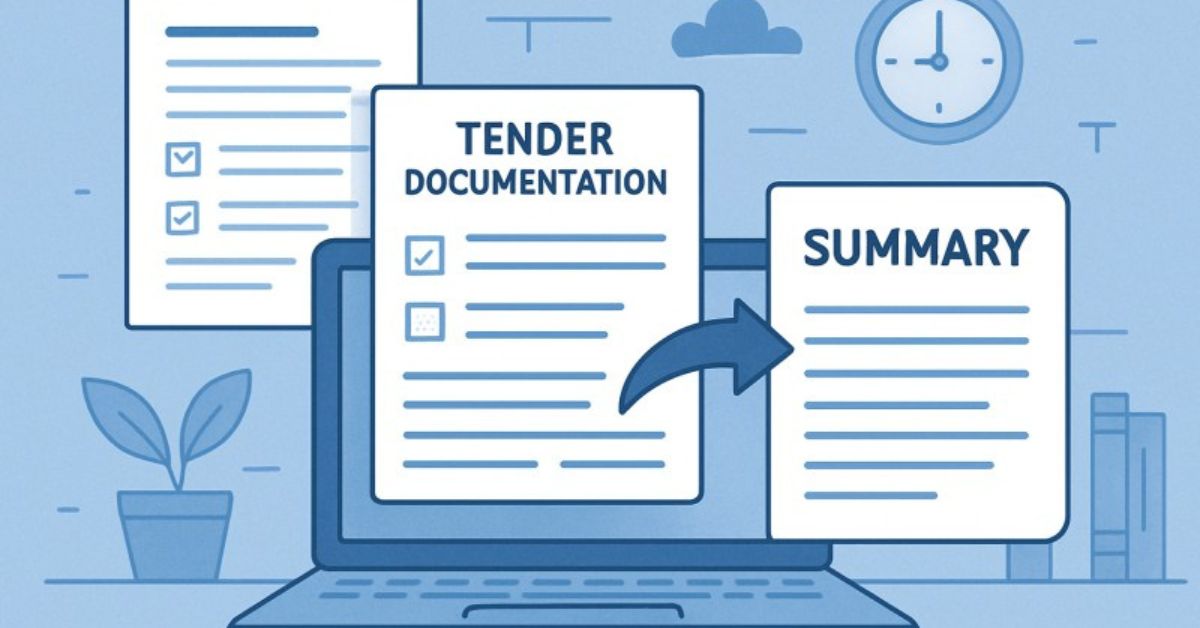Applies to: All Hermix plans and features
Reading Time: 5 min
Last Updated: July 22 2025
Skip the 300-Page Grind
Tender specifications can run beyond 300 pages. They overflow with legal references, annexes, and specialist jargon that bury the details you actually need. Reading them cover to cover steals hours from proposal work. Hermix’s AI Tender Summarization feature gives those hours back.
What You’ll Learn
By the end of this article, you’ll know how to use AI summaries to scan any tender in seconds and decide what deserves deeper attention.
What You Need
A Hermix account unlocks the summarization button on every opportunity. Start a free trial at hermix.com/sign-up if you want to follow along.
Key Takeaways
- Generate concise summaries that highlight scope, budget, and eligibility.
- Cut preliminary document review time by up to 85 percent.
- Share AI summaries with teammates so everyone starts on the same page.
Why Manual Reading Fails
Traditional tender review looks like this:
- Download a multi-hundred-page PDF.
- Skim for keywords.
- Copy sections into a note.
- Hope nothing critical slips past tired eyes.
Teams often assign a senior consultant to this task, which delays higher-value work. Hermix automates the first pass so specialists can focus on strategy instead of sifting text.
How AI Tender Summarization Works
- Document Ingest
Hermix pulls the full tender file directly from the portal. No manual downloads. - Natural-Language Processing
Our model reads the document end-to-end, extracts core elements, and flags mandatory requirements. - Structured Output
The summary lists scope, budget range, key deadlines, evaluation criteria, and eligibility checkpoints in plain language.
Accuracy tests across English, French, and Slovene tenders show 98–99 percent precision on these fields.
Three-Step Quick Scan
- Open any opportunity inside Hermix.
- Click Tender summarization.
- Read the summary that appears beneath the document viewer.
That is it. Super simple, right?
Practical Use Cases
- Bid/No-Bid Triage
Decide within minutes whether the tender suits your capabilities and price point. - Team Briefings
Email the summary to legal, finance, and technical leads so everyone starts with the same facts. - Delegation
Junior team members can run summaries and escalate only the tenders that match strategic criteria.
Real-World Impact
Users report saving two to three hours per medium-size tender and up to eight hours on large framework notices. Over a quarter, those hours translate into more proposals submitted and sharper qualification decisions.
Best Practices
- Run the summary before downloading annexes.
- Cross-check any critical figure (budget, contract length) against the source page when the tender is a top priority.
- Store summaries in My Files so new team members see past decisions instantly.
Common Pitfalls
- Ignoring context: always pair the summary with buyer history from the Context tab.
- Copy-paste bids: a summary is a starting point, not a replacement for tailored proposals.
- Single-language searches: Hermix summarises in the document’s original language, so keep multilingual skills handy for final reviews.
Measuring Success
Track:
- Average time from tender release to initial decision.
- Number of high-quality bid/no-bid calls made per month.
- Team hours reallocated from reading to solution design.
Aim for an 80 percent cut in preliminary reading within your first month.
Test It Now
Open any tender in your Hermix dashboard, press Tender summarization, and see how fast clarity arrives.
Related Resources
Next Steps
- Next knowledge base article
Advanced Features
- Monitor Public Sector Opportunities
- Opportunity Analysis and Qualification
- Market Intelligence
European Commission Market Analysis - Collaboration Tools

